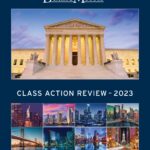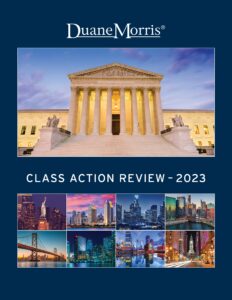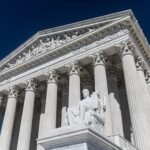 Duane Morris Takeaways: As our Duane Morris Class Action Review outlines, 2022 was a year of history making developments in the class action world. The Review is the preeminent resource for discussing the trends of 2022 and what to expect in 2023. Below is a video exploring the origin of the Review, presented by Jerry Maatman and Jennifer Riley, partners at Duane Morris, Co-Chairs of the Firm’s class action defense group, and the Review editors. Check it out below:
Duane Morris Takeaways: As our Duane Morris Class Action Review outlines, 2022 was a year of history making developments in the class action world. The Review is the preeminent resource for discussing the trends of 2022 and what to expect in 2023. Below is a video exploring the origin of the Review, presented by Jerry Maatman and Jennifer Riley, partners at Duane Morris, Co-Chairs of the Firm’s class action defense group, and the Review editors. Check it out below:
Illinois Appellate Court Affirms Dismissal Of BIPA Class Action Lawsuit
 By Gerald L. Maatman, Jr., Jennifer A. Riley, and Alex W. Karasik
By Gerald L. Maatman, Jr., Jennifer A. Riley, and Alex W. Karasik
Duane Morris Takeaways: In Barnett v. Apple Inc., Case No. 1-22-0187, 2022 Ill. App. LEXIS 556 (Ill. App. 1st Dist. Dec. 23, 2022), after a trial court dismissed a biometric privacy class action lawsuit involving the use of facial and fingerprint recognition features, the Illinois Appellate Court affirmed the dismissal order. In an important decision defining the parameters of liability under the Illinois Biometric Information Privacy Act (“BIPA”), the Illinois Appellate Court held that the users of the technology themselves were responsible for possessing, capturing, and collecting their biometric data
For businesses that are confronted with biometric privacy class action allegations in the context of recognition software, this monumental victory for Apple provides an excellent roadmap to attack such claims at the pleading stage.
Case Background
Plaintiffs alleged that Apple violated the Biometric Information Privacy Act, 740 ILCS 14/1 et seq., by offering users of its phones and computers the option of utilizing face and fingerprint recognition features without first instituting a written policy regarding the retention and destruction of the users’ biometric information; and without first obtaining the users’ written consent. Id. at *1-2. Plaintiffs claimed Apple was “in possession of,” “collected,” and “captured,” the users’ biometric information, since Apple designed, owned, and had the ability to remotely update the software. Id. at *2.
On January 3, 2022, the trial court granted Apple’s motion to dismiss. Id. at *9. First, the trial court held that Plaintiffs failed to allege that their biometric information was sent to Apple’s servers or any third party server. Rather, Plaintiffs expressly alleged that the information was stored locally on Plaintiffs’ own devices. Second, the trial court held that Plaintiffs did not allege that Apple stored any of Plaintiffs’ biometric data in Apple databases. Third, the trial court held that it was clear Plaintiffs voluntarily chose to use Face ID and Touch ID features, and could delete their biometric information from their devices if they chose. On February 2, 2022, Plaintiffs filed a timely notice of appeal. Id. at *11.
The Illinois Appellate Court’s Decision
The Illinois Appellate Court affirmed the trial court’s dismissal of Plaintiffs’ complaint. Addressing the issue of “possession,” the Appellate Court explained that the term was not defined in the BIPA statute. Id. at *16. Plaintiffs argued that Apple ‘possesse[d]” their information because Apple software collected and analyzed their information. Id. at *17. Rejecting Plaintiffs’ argument, the Appellate Court opined that based on the facts alleged by Plaintiffs, it seemed as though Apple designed these features with the express purpose of handing control to the user. Id. at *17-18. The Appellate Court also noted that these features were completely elective, explaining that the user must undertake a series of affirmative steps in order to use them. Id. Finally, the Appellate Court found that Plaintiffs’ arguments were not persuasive since Plaintiffs alleged that the information is stored on the users’ own individual devices, and that users may delete the information and disable the features at their convenience. Accordingly, the Appellate Court held that Plaintiffs failed to properly allege that Apple possessed their biometric information.
Turning to the issue of whether Apple collected and captured Plaintiffs’ biometric information, the Appellate Court explained that these terms were also not defined in the BIPA statute. Id. at *20. In support of their proposed definitions, Plaintiffs cited a BIPA class action in the employment context, where the employee plaintiff was required to use the biometric scanner or lose her job. Id. at *22-23 (citations omitted). Rejecting Plaintiffs’ argument, the Court noted that the biometric features in this care were wholly optional, the information was stored exclusively on Plaintiffs’ devices, and Plaintiffs could delete the information at will. Further, the Court noted that Plaintiffs specifically alleged that the information is stored only on their devices. Accordingly, the Appellate Court held that Plaintiffs failed to properly allege that Apple captured and collected their biometric information.
In conclusion, the Appellate Court summarized its findings as follows: “[P]laintiffs do not dispute that the user’s biometric information is stored on the user’s own device; that Apple does not collect or store this information on a separate server or device; that these features are completely optional; that the user is the sole entity deciding whether or not to use these features; that, to enable the features, the user employs his or her own device to capture and collect his or her own biometric information on that device; that, to utilize these features, the user must undertake a number of steps, which are all documented in photos in plaintiffs’ complaint; and that the user has the power to delete this biometric information from the device, at any time, without negatively impacting the device.” Id. at *22-23. Accordingly, the Appellate Court affirmed the trial court’s dismissal of Plaintiffs’ BIPA class action.
Implications For Employers
Facial recognition technology is rapidly becoming more prevalent in both the employment and consumer contexts. This decision underscores the importance of carefully analyzing the allegations in biometric privacy class action pleadings. In situations where users maintain control over their own biometric data, this may be a helpful decision to seek an early exit from the lawsuit. Finally, Apple’s victory further provides some optimism for companies defending biometric privacy class actions, as the recent tide of key decisions has largely been adverse to defendants.
Check Out The Duane Morris Class Action Review Website
 By Gerald L. Maatman, Jr. and Jennifer A. Riley
By Gerald L. Maatman, Jr. and Jennifer A. Riley
Duane Morris Takeaways – The all-new Duane Morris Class Action Review can be viewed on its very own website – click here to see everything offered! View the Top 10 Trends and settlements in all areas of class action litigation for 2022 here. You can also preorder the Review eBook here and review the Duane Morris Class Action Review Overview Video, featuring partners Jerry Maatman and Jennifer Riley here.
The Class Action Review
This one-of-a-kind publication provides a comprehensive analysis of class action litigation trends and significant rulings and settlements from 2022 that will enable corporate counsel and business leaders to make informed decisions when dealing with complex litigation risks in 2023.
The Review is 450 pages long, including 23 substantive chapters (with extensive charts and graphics), and 4 appendices, and is available in hard copy and e-Book formats.
It covers every conceivable area of substantive law involving class actions brought against corporate defendants. Our goal is to provide readers with the definitive desk reference for dealing with the complexities of class action litigation
We hope our loyal blog readers enjoy the Review! Stay tuned for more video and blog content highlighting each Top 10 Trend, and for an invitation to a Duane Morris exclusive in-Person and webinar Book Launch event!
It Is Here — The Duane Morris Class Action Review – 2023
 By Gerald L. Maatman, Jr. and Jennifer A. Riley
By Gerald L. Maatman, Jr. and Jennifer A. Riley
Duane Morris Takeaways: As we kick off 2023, this is the inaugural year of the new Duane Morris Class Action Review. It is a one-of-its-kind publication analyzing class action trends, decisions, and settlements in all areas impacting Corporate America, including the substantive areas of antitrust, appeals, the Class Action Fairness Act, civil rights, consumer fraud, data breach, EEOC-Initiated and government enforcement litigation, employment discrimination, the Employee Retirement Income Security Act of 1974, the Fair Credit Reporting Act, wage & hour class and collective actions, labor, privacy, procedural issues, product liability and mass torts, the Racketeer Influenced and Corrupt Organizations Act, securities fraud, state court class actions, the Telephone Consumer Protection Act, and the Worker Adjustment and Retraining Notification Act. The Review also highlights key rulings on attorneys’ fee awards in class actions, motions granting and denying sanctions in class actions, and the top class action settlement in each area. Finally, the Review provides insight as to what companies and corporate counsel can expect to see in 2023.
Click here to access our customized website featuring all the Review highlights, including the ten major trends across all types of class actions over the past year.
Order your copy of the eBook here, and download the Review overview on the key Rule 23 decisions and top class action settlements here.
The 2023 Review analyzes rulings from all state and federal courts in 23 areas of law. It is designed as a reader-friendly research tool that is easily accessible in hard copy and e-Book formats. Class action rulings from throughout the year are analyzed and organized into 23 chapters and 4 appendices for ease of analysis and reference.
Executive Summary Of Key Class Action Trends Over The Past Year
Class action litigation presents one of the most significant risks to corporate defendants today. Procedural mechanisms like the one set forth in Rule 23 of the Federal Rules of Civil Procedure have the potential to expand a claim asserted on behalf of a single person into a claim asserted on behalf of a behemoth that includes every employee, customer, or user of a particular company, product, or service, over an extended period. With the potential for exponential enlargement of the size and scope of an action comes the potential for exponential expansion of peril for a corporate defendant. Class action lawsuits can create legal nightmares for companies and their management teams. The exposure created by such aggregation of claims can pose a challenge to a corporation’s balance sheet, market share, and reputation. Sometimes such litigation can push a defendant into bankruptcy.
With the growth of class action litigation over the past decade, counsel for defendants and plaintiffs alike have become more sophisticated, the statutory authority and case law precedents have continued to evolve, and parties on both sides have expanded their arsenal of tools to pursue and to defend these cases. As a result, class action litigation entails ever-changing guideposts, new playbooks, and innovation. The plaintiffs’ class action bar used Rule 23 to its fullest in 2022 in prosecuting class actions against Corporate America. The result was a year like no other in the class action space.
defendants and plaintiffs alike have become more sophisticated, the statutory authority and case law precedents have continued to evolve, and parties on both sides have expanded their arsenal of tools to pursue and to defend these cases. As a result, class action litigation entails ever-changing guideposts, new playbooks, and innovation. The plaintiffs’ class action bar used Rule 23 to its fullest in 2022 in prosecuting class actions against Corporate America. The result was a year like no other in the class action space.
We identified 10 key trends that characterize the past year. These trends involve: (i) massive class action settlements; (ii) U.S. Supreme Court decisional law on class action issues; (iii) set-backs and statutory impediments to the arbitration defense; (iv) plaintiff-friendly class certification conversion rates; (v) a simmering in government enforcement actions paired with indications of more aggressive federal and state agency litigation against corporations in the coming year; (vi) expansive growth in privacy class action litigation; (vii) an expansion of data protection issues that continue to plague corporate defendants; (viii) continued confusion over the problem of uninjured class members to class certification; (ix) aggressive assertion of defenses based on personal jurisdiction and venue; and (x) transformative rulings on the PAGA front including the first major setback for the plaintiffs’ bar.
Trend #1 – Class Action Settlements In 2022 Redistributed Wealth At An Unprecedented Level
Aside from the Big Tobacco settlements nearly two decades ago, 2022 marked the most extensive set of billion-dollar class action settlements in the history of the American court system. Many of these settlements arose from opioid litigation against manufactures, distributors, and retailers in the  pharmaceutical industry. On an aggregate basis, class actions and government enforcement lawsuits garnered more than $71 billion in settlements, with 15 class action cases settling for more than $1 billion. These settlements have redistributed wealth at an unprecedented rate. Suffice to say, 2022 was unlike any other year on the class action settlement front. As success often begets copy-cats, corporations can expect the plaintiffs’ class action bar will be equally if not more aggressive in their case filings and settlement positions in 2023.
pharmaceutical industry. On an aggregate basis, class actions and government enforcement lawsuits garnered more than $71 billion in settlements, with 15 class action cases settling for more than $1 billion. These settlements have redistributed wealth at an unprecedented rate. Suffice to say, 2022 was unlike any other year on the class action settlement front. As success often begets copy-cats, corporations can expect the plaintiffs’ class action bar will be equally if not more aggressive in their case filings and settlement positions in 2023.
Trend # 2 – The U.S. Supreme Court’s Decisions In 2022 Continued To Define The Class Action Landscape
As the ultimate referee of law, the U.S. Supreme Court has continued to define and shift the playing field for class action litigation. The Supreme Court’s rulings in 2022 were no exception. Consistent with its approach over the past several years, the Supreme Court issued three key rulings that impact the plaintiffs’ bar’s ability to bring and maintain class actions. The rulings include Southwest Airlines Co. v. Saxon, et al., 142 S.Ct. 1783 (2022), Morgan, et al. v. Sundance, Inc., 142 S.Ct. 1708 (2022), and Viking River Cruises, Inc. v. Moriana, et al., 142 S.Ct. 1906 (2022). The most effective tool for combating class actions may be the arbitration defense. Contrary to the tendency of its rulings in recent years to expand the arbitration defense, and thus make it more difficult for the plaintiffs’ bar to pursue claims on a class-wide basis, this past year the U.S. Supreme Court pulled back on the arbitration defense by narrowing its coverage.
Southwest Airlines Co. v. Saxon, et al., 142 S.Ct. 1783 (2022), Morgan, et al. v. Sundance, Inc., 142 S.Ct. 1708 (2022), and Viking River Cruises, Inc. v. Moriana, et al., 142 S.Ct. 1906 (2022). The most effective tool for combating class actions may be the arbitration defense. Contrary to the tendency of its rulings in recent years to expand the arbitration defense, and thus make it more difficult for the plaintiffs’ bar to pursue claims on a class-wide basis, this past year the U.S. Supreme Court pulled back on the arbitration defense by narrowing its coverage.
Trend # 3 – The Arbitration Defense Suffered Setbacks In 2022
Of all defenses, a defendant’s ability to enforce an arbitration agreement containing a class or collective action waiver may have had the single greatest impact in terms of shifting the pendulum of class action litigation. With its decision in Epic Systems Corp. v. Lewis, et al., 138 S. Ct. 1612 (2018), the U.S. Supreme Court cleared the last hurdle to widespread adoption of such agreements. In response, more companies of all types and sizes updated their onboarding materials, terms of use, and other types of agreements to require that any disputes be resolved in arbitration on an individual basis. To date, companies have enjoyed a high rate of success enforcing those agreements and using them to thwart class actions out of the gate. Given the impact of the arbitration defense, in 2023, companies may face additional hurdles, on the judicial or the legislative front, as the plaintiffs’ bar continues to look for workarounds.
Trend # 4 – The Likelihood Of Class Certification In 2022 Was As Strong As Ever
In 2022, the plaintiffs’ class action bar succeeded in certifying class actions at a high rate. Across all major types of class actions, courts issued rulings on over 360 motions to grant or to deny class certification in 2022. Of these, plaintiffs succeed in obtaining or maintaining certification in 268 rulings, with an overall success rate of nearly 75%. The plaintiffs’ class action bar obtained the highest rates of success in securities fraud, ERISA, WARN, and FLSA actions. In cases alleging securities fraud, plaintiffs succeeded in obtaining orders certifying classes in 23 of the 24 rulings issues during 2022, a success rate of 96%. In ERISA litigation, plaintiffs succeeded in obtaining orders certifying class in 18 of 23 rulings issued during 2022, a success rate of 78%. In cases alleging WARN violations, plaintiffs managed to certify classes in 100% of the suits that resulted in decisions this year.
Trend # 5 – Government Enforcement In 2022 Took A Back Seat
Over the past year, the Biden Administration continued to roll out changes on several fronts as it aimed to expand the rights, remedies, and procedural avenues available to workers. During 2022, such efforts fueled litigation. With its decision in West Virginia v. Environmental Protection Agency, 142 S.Ct. 2587 (2022), the U.S. Supreme Court imposed another hurdle to agency rule- making. Meanwhile, government enforcement litigation activity took a back seat. Over the past two years, the U.S. Department of Labor, in particular, has continued to roll out worker-friendly rules that could have a cascading impact on workplace class actions, including rules designed to wipe out the pro-business policies of the Trump Administration. Such efforts continued on multiple fronts in 2022, including with respect to rules regarding businesses’ utilization of independent contractors and their use of the tip credit. Whereas companies continued to see pro-business rules promulgated by the Trump Administration withdrawn and overwritten in 2022, courts continued to impose hurdles to agency rulemaking, the success of which will continue to be seen in 2023. Enforcement activity remained steady as political appointments remain pending. Employers are apt to see increased activity in 2023 as the EEOC in particular gains its full component of Biden appointees and can exercise its majority power to advance its agenda.
making. Meanwhile, government enforcement litigation activity took a back seat. Over the past two years, the U.S. Department of Labor, in particular, has continued to roll out worker-friendly rules that could have a cascading impact on workplace class actions, including rules designed to wipe out the pro-business policies of the Trump Administration. Such efforts continued on multiple fronts in 2022, including with respect to rules regarding businesses’ utilization of independent contractors and their use of the tip credit. Whereas companies continued to see pro-business rules promulgated by the Trump Administration withdrawn and overwritten in 2022, courts continued to impose hurdles to agency rulemaking, the success of which will continue to be seen in 2023. Enforcement activity remained steady as political appointments remain pending. Employers are apt to see increased activity in 2023 as the EEOC in particular gains its full component of Biden appointees and can exercise its majority power to advance its agenda.
Trend # 6 – Privacy Class Actions Became An Intense Focus Of The Plaintiffs’ Class Action Bar
Privacy litigation – in a multitude of forms and theories – manifested itself as the hottest area of growth in terms of activity by the plaintiffs’ class action bar. The Illinois Supreme Court likely will rule on key BIPA matters in the early part of 2023 and that the statute will continue to drive class action litigation. Its technical requirements, combined with stiff statutory penalties and fee-shifting, provide a recipe for attention from the plaintiff’s class action bar, and companies’ continued development and use of innovative technologies are apt to provide a veritable barrel of opportunity. The plaintiffs’ bar also grounded privacy claims in the electronic interception provisions of various state laws. While Congress has refrained from addressing data privacy through federal legislation, many states have enacted their own laws, and 2022 saw significant state legislative activity regarding data privacy with five states preparing for new privacy laws to take effect in 2023, including California, Colorado, Connecticut, Utah, and Virginia.
Trend # 7 – Data Protection Issues Continued To Plague Corporate Defendants
Companies that fall victim to data breach attacks have to contend not only with the significant costs of responding to the data breach and potential of government fines, but also the high costs of dealing with high-stakes class action lawsuits. Corporations also suffered setbacks as courts disagreed over the application of the U.S. Supreme Court’s decision in TransUnion v. Ramirez, et al., 141 S. Ct. 2190 (2021), to data breach cases. In TransUnion, the Supreme Court ruled that certain putative class members, who did not have their credit reports shared with third parties, did not suffer concrete harm and, therefore, lacked standing to sue. The Supreme Court decision in Ramirez has not resulted in a bright line rule on standing in data breach cases, as courts continue to apply different interpretations of Ramirez when analyzing the particular circumstances surrounding the breach in assessing the question of standing.
the application of the U.S. Supreme Court’s decision in TransUnion v. Ramirez, et al., 141 S. Ct. 2190 (2021), to data breach cases. In TransUnion, the Supreme Court ruled that certain putative class members, who did not have their credit reports shared with third parties, did not suffer concrete harm and, therefore, lacked standing to sue. The Supreme Court decision in Ramirez has not resulted in a bright line rule on standing in data breach cases, as courts continue to apply different interpretations of Ramirez when analyzing the particular circumstances surrounding the breach in assessing the question of standing.
Trend # 8 – Courts Continued To Grapple With Problems Of Standing And Uninjured Class Members
During 2022, courts continued to grapple with the rules that govern the certification of classes that contain uninjured class members. Various cases climbed to the federal circuit level, with varying results, and the U.S. Supreme Court once again declined to take up the issue, making uninjured class members a continued topic of disagreement and debate for 2023. The issue remains one that divides lower federal courts, thereby fueling uncertainty on an important class action issue. If a defendant’s showing that one or more members of the defined class did not suffer a concrete harm can defeat class certification, such a defense is a potent tool for the defense. As a result, while 2022 saw the further development of the defense, corporate defendants are likely to see continued litigation over this issue during the upcoming year.
Trend # 9 – Corporate Defendants Aggressively Asserted Defenses Based On Personal Jurisdiction
In 2022, corporate defendants aggressively asserted defenses based on personal jurisdiction to fracture class and collective actions. In Bristol-Myers Squibb Co. v. Superior Court of California, San Francisco County, 137 S. Ct. 1773 (2017), the U.S. Supreme Court held that each plaintiff in a mass action must demonstrate a basis for the court to exercise personal jurisdiction over the defendant for purposes of adjudicating his or her claims, even if those claims are similar to the claims of other plaintiffs. Federal circuits, however, have disagreed on the impact of the Supreme Court’s ruling in the collective action and class action context. It is unlikely that the Supreme Court will resolve this issue in 2023, and corporate defendants can expect that personal jurisdiction will remain a powerful defense for facing class and collective actions outside of their home states.
Trend # 10 – PAGA Actions Suffered Their First Setback, Work-Arounds Continued To Percolate
In 2022, actions under the California Private Attorneys General Act (PAGA), Cal. Lab. Code, §§ 2698, et seq., saw their first setback as a workaround to workplace arbitration programs that require individual proceedings. According to data maintained by the California Department of Industrial Relations, the number of PAGA notices filed with the LWDA has increased exponentially over the past two decades. As the adoption of arbitration programs gained popularity as a mechanism to contract around class and collective actions, the plaintiffs’ class action bar identified work-around strategies. The PAGA workaround suffered its first significant set-back in 2022 with the U.S. Supreme Court’s highly anticipated decision in Viking River Cruises, Inc. v. Moriana, et al., 142 S.Ct. 1906 (2022), which addressed the arbitrability of PAGA claims.
What Should Companies Expect In 2023?
Class action litigation is a staple of the American judicial system. The volume of class action filings has increased each year for the past decade, and 2023 is likely to follow that trend. A company’s programs designed to ensure  compliance with existing laws and strategies to mitigate class action litigation risks are corporate imperatives. The plaintiffs’ bar is nothing if not innovative and resourceful. Given the massive class action settlement figures in 2022, coupled with the ever-developing case law under Rule 23, corporations can expect more lawsuits, expansive class theories, and an aggressive plaintiffs’ bar in 2023. These conditions necessitate planning, preparation, and decision-making to position corporations to withstand and defend class action exposures. These crucial issues are inevitably posed by any class action litigation. By their very nature, class actions involve decisions on strategy at every turn. The positions of the parties are constantly changing and corporate defendants must always be looking ahead and anticipating issues during every phase of the litigation.
compliance with existing laws and strategies to mitigate class action litigation risks are corporate imperatives. The plaintiffs’ bar is nothing if not innovative and resourceful. Given the massive class action settlement figures in 2022, coupled with the ever-developing case law under Rule 23, corporations can expect more lawsuits, expansive class theories, and an aggressive plaintiffs’ bar in 2023. These conditions necessitate planning, preparation, and decision-making to position corporations to withstand and defend class action exposures. These crucial issues are inevitably posed by any class action litigation. By their very nature, class actions involve decisions on strategy at every turn. The positions of the parties are constantly changing and corporate defendants must always be looking ahead and anticipating issues during every phase of the litigation.
We hope the Duane Morris Class Action Review provides practical insights into complex potential strategies relevant to all aspects of class action litigation and other claims that can cost billions of dollars and require changed business practices in order to resolve
The 2022-2023 Judicial Hellholes Report From The American Tort Reform Association On The Worst Jurisdictions For Defendants
 By Gerald L. Maatman, Jr. and Jennifer A. Riley
By Gerald L. Maatman, Jr. and Jennifer A. Riley
Duane Morris Takeaways: Every year the American Tort Reform Association (“ATRA”) publishes its “Judicial Hellholes Report,” focusing on litigation issues and identifying jurisdictions likely to have unfair and biased administration of justice. The ATRA recently published its 2022-2023 Report and Georgia is identified as the most disadvantageous jurisdiction in the country for corporate defendants, the highest ever ranking for the state. Readers can find a copy here and the executive summary here.
The Judicial Hellholes Report is an important read for corporate counsel facing class action litigation because it identifies jurisdictions that are generally unfavorable to defendants. The Report defines a “judicial hellhole” as a jurisdiction where judges in civil cases systematically apply laws and procedures in an unfair and unbalanced manner, generally to the disadvantage of defendants. The Report is a “must read” for anyone litigating class actions and making decisions about venue strategy.
The 2022 Hellholes
In its recently released annual report, the ATRA identified 8 jurisdictions on its 2022 hellholes list – which, in order, include: (1) Georgia (with massive verdicts bogging down business and third-party litigation financing is playing an increasing role in litigation); (2) Pennsylvania (especially in the Philadelphia Court of Common Pleas and the Supreme Court of Pennsylvania); (3) California (with Proposition 65 lawsuits thriving and a huge overall volume of lawsuits, in addition to Private Attorney General Act (PAGA) litigation and Americans with Disability Act (ADA) accessibility lawsuits; (4) New York (with “no-injury” consumer class action lawsuits and the highest volume of lawsuits under the ADA); (5) Illinois (particularly in Cook County as another “no-injury required” hotspot and lawsuits stemming from the Illinois Biometric Information Privacy Act); (6) South Carolina (particularly in asbestos litigation); (7) Louisiana (including deceptive lawsuit advertising practices, coastal litigation, and COVID-19 litigation); and (8) St. Louis, Missouri (with focuses on asbestos litigation and “phantom damages”).
According to the ATRA’s analysis, these venues are less than optimal for corporate defendants and often attract plaintiffs’ attorneys, particularly for the filing of class action lawsuits. Therefore, corporate counsel should take particular care if they encounter a class action lawsuit filed in one of these venues.
The 2023 “Watch List”
The ATRA also included 3 jurisdictions on its “watch list,” including Florida (the ATRA noted that Florida has been making strides to mitigate lawsuit abuse, but issues of inflated medical damages and deceptive trial lawyer advertising still remain); New Jersey (with a powerful trial bar), and Texas (particularly the Court of Appeals for the Fifth District, which the ATRA opined has developed a reputation for being pro-plaintiff and pro-liability expansion).
In addition, the ATRA recognized that several jurisdictions made significant positive improvements this year, highlighting decisions issued by Florida Supreme Court, the U.S. Court of Appeals for the Fourth Circuit, and the Arizona Supreme Court. The ATRA also noted that nine state legislatures enacted positive civil justice reforms this year.
Implications For Employers
The Judicial Hellholes Report often mirrors the experience of companies in high-stakes class actions, as Georgia, California, New York, Pennsylvania, Illinois, Louisiana, Missouri, and South Carolina are among the leading states where plaintiffs’ lawyers file class actions. These jurisdictions are linked by class certification standards that are more plaintiff-friendly and more generous damages recovery possibilities under state laws.
Sixth Circuit Denies Writ Of Mandamus In Opioid Class Actions For District Court’s Order That Pushes Discretion Under Rule 16(b) to the Edge
 By Gerald L. Maatman, Jr., Jennifer A. Riley, and Shaina Wolfe
By Gerald L. Maatman, Jr., Jennifer A. Riley, and Shaina Wolfe
Duane Morris Takeaways: In the proceeding entitled In Re National Prescription Opiate Litigation, No. 21-4051, 2022 U.S. App. LEXIS 31328 (6th Cir. Nov. 10, 2022), the Sixth Circuit denied a petition for writ of mandamus regarding a District Court’s Scheduling Order in the giant opioid multidistrict class action and its allowance of the late pleadings amendments as to new defendants, Meijer Distribution, Inc., and Meijer Stores Limited Partnership (“Meijer Defendants”). The newly-added Meijer Defendants argued that the District Court violated the Rule 16(b) of the Federal Rules of Civil Procedure by allowing Plaintiffs to improperly join them in the ongoing 3-year old case without first seeking leave of court and without demonstrating good cause. The Sixth Circuit held that the District Court acted within its broad discretion and did not violate the Federal Rules of Civil Procedure because it provided a cut-off date that allowed for the specific amendments. The Sixth Circuit explained “[t]hough unconventional, the District Court’s actions are not so extraordinary as to warrant mandamus.” Id. at *1. The decision illuminates the broad discretion that district courts enjoy in managing class action litigation and the important role that scheduling orders play throughout the entire litigation.
Case Background
In July 2018, Plaintiffs filed the underlying lawsuit against a group of pharmacies. The case was removed to federal court and ultimately became part of the opioid multidistrict class action proceeding entitled In Re National Prescription Opiate Litigation, 1:17-MD-2804 (N.D. Ohio 2017) (“MDL”).
Significantly, in the underlying case, the district court entered an order on May 3, 2018, which amended its Case Management Order and provided that “‘[i]f a case is later designated as a bellwether for motion practice or trial, a separate CMO will be entered that will provide further opportunity to amend.’” (“2021 Bellwether Order”). See Petition at 4-5.
In 2021, the District Court selected the underlying case to proceed as a bellwether case against the pharmacies. See Sixth Circuit Order at 1. Subsequently, on May 19, 2021, Plaintiff filed a supplemental pleading, adding the Meijer Defendants to the underlying case. See id.; Petition at 5. The amendments were made nearly three years after Plaintiff filed suit and more than 26 months after the deadline to add new defendants.
After unsuccessfully moving to strike the Meijer Amendments and certify the Court’s 2021 Bellwether Order for interlocutory appeal, on November 9, 2021, Defendants filed a petition for a writ of mandamus with the Sixth Circuit. See Petition at 7. In the Petition, the Meijer Defendants argued that the District Court allowed Plaintiff to add the Meijer Defendants years after the deadline for amending pleadings passed and without requiring Plaintiff to demonstrate good cause, as required by Rule 16(b) of the Federal Rules of Civil Procedure. See Petition at 1. The Meijer Defendants requested that the Sixth Circuit issue a writ ordering the District Court to strike the untimely amendments and dismiss the Meijer Defendants from the case. See id. at 2.
The Sixth Circuit’s Ruling Denying The Writ Of Mandamus
The Sixth Circuit denied the writ of mandamus. It held that the District Court’s order, while “unconventional,” fell within the parameters of Rule 16(b). See Sixth Circuit Order at 1. The Court of Appeals explained that Rule 16(b) requires that “scheduling orders limit the time to join other parties” and the District Court’s 2021 Bellwether Order “explicitly provided permission for plaintiffs to amend their complaint if their case was selected as a bellwether.” Id. The Sixth Circuit reasoned that because Plaintiffs exercised their right to amend after the underlying case was chosen as a bellwether, Plaintiffs did not need to seek permission from the District Court. Id. at 2.
The Sixth Circuit noted that the 2021 Bellwether Order allowed plaintiffs to amend whenever their case was selected as a bellwether, and there was no cut-off for amendments. Id. The Sixth Circuit acknowledged that, under the 2021 Bellwether Order and without any cut-off date, the amendments could have gone differently (i.e., made on the eve of trial or adding a defendant that was completely new to the litigation). Id. at 2. Instead, the Sixth Circuit determined that the Meijer Defendants suffered little, if any, prejudice. Id. at 2-3. Thus, the Court of Appeals explained, “[t]hat unusual aspect of the scheduling order did not clearly violate Rule 16 because it provided some limit (when the case was selected as a bellwether), although the order went right to the edge of the district court’s discretion under Rule 16.” Id. at 2.
In denying the writ, the Sixth Circuit held that the Meijer Defendants “ha[ve] shown that the district court’s scheduling order was unconventional but not a judicial usurpation of power nor a clear abuse of discretion.” Id. at 3.
Implications For Companies
The Sixth Circuit’s order recognizes the broad discretion that district courts have in managing their dockets and illustrates the importance that scheduling orders play in all types of cases, and specifically in MDLs and class actions. Companies should pay close attention to all of the proposed deadlines included in any scheduling orders, and try to prevent these types of amendments from being entered at the outset.
Ohio State Wins More Than Just Games, As The Ohio Court of Appeals Reverses Class Certification In Favor Of The University
By Gerald L. Maatman, Jr., Jennifer A. Riley, Shaina Wolfe
Duane Morris Synopsis – In Smith v. Ohio State University, 2022-Ohio-4101 (Ohio App. Nov. 17, 2022), The Ohio State University successfully appealed an Ohio Court of Claim’s (“ trial court”) Order granting class certification in a lawsuit brought by a former undergraduate student. The former student alleged that when the university only offered online classes due to COVID-19, it breached its contract by keeping all the tuition payments from her and other students without giving them the robust in-person experience promised when they initially paid their tuition bills. The Ohio Court of Appeals held that while the trial court has broad discretion in granting class certification, it failed to determine proof of injury and economic damages relative to the former student and potential class members. In crafting a class certification defense strategy, especially in a breach of contract case where the injury and damages typically are in play, employers should focus on the lawsuit basics when opposing class certification, i.e., demanding that plaintiffs show causation and injury in fact.
trial court”) Order granting class certification in a lawsuit brought by a former undergraduate student. The former student alleged that when the university only offered online classes due to COVID-19, it breached its contract by keeping all the tuition payments from her and other students without giving them the robust in-person experience promised when they initially paid their tuition bills. The Ohio Court of Appeals held that while the trial court has broad discretion in granting class certification, it failed to determine proof of injury and economic damages relative to the former student and potential class members. In crafting a class certification defense strategy, especially in a breach of contract case where the injury and damages typically are in play, employers should focus on the lawsuit basics when opposing class certification, i.e., demanding that plaintiffs show causation and injury in fact.
Case Background
Plaintiff, a former college student, filed a lawsuit alleging that Defendant, The Ohio State University (“OSU”), breached its contract and received unjust enrichment in Spring 2020 by failing to partially refund students their tuition and fees after transitioning from their robust, in-person education to “subpar” online education during COVID-19. Id. at 4-5.
In June 2021, Plaintiff moved for class certification. Id. at 5. After briefing and oral argument, the trial court granted Plaintiff’s motion and certified a class consisting of all undergraduate students enrolled in classes at Defendant’s Columbus campus during the Spring 2020 semester. Notably, the trial court found that the class suffered the same injury, i.e., losing the benefit of in-person classes and access to the campus. Id. at 9-10.
In appealing the trial court’s decision, Defendant raised several arguments for why the trial court’s decision was incorrect. Significantly, Defendant’s main, and ultimately successful, arguments focused on the trial court’s failure to conduct the “rigorous analysis” required by Ohio Civil Rule 23 (like Federal Rule of Civil Procedure 23) in determining whether Plaintiff had satisfied the prerequisites for class certification. Id. at 10-11.
The Court Of Appeals’ Ruling Reversing Class Action Certification
The Ohio Court of Appeals agreed with Defendant and reversed the trial court’s order granting class certification for three reasons.
First, the Court of Appeals found that the Plaintiff failed to present sufficient evidence of an economic injury. Id. at 17-18. Instead, the trial court simply assumed that a “benefit” was lost based only on the fact Defendant closed its campus and switched to remote classes and services in response to the pandemic. Id. at 18.
Second, the Court of Appeals found that the trial court failed to consider Defendant’s arguments and evidence contesting proof of injury. Id. at 18-19. Defendant submitted an expert report that included evidence that students paid the same for in-person and online learning and that the in-person teaching modality carried the possibility of substantial remote instruction even in a normal semester. Id. at 19. Meanwhile, Plaintiff submitted no expert testimony regarding how and or whether other students were injured in this case. Id. Indeed, Plaintiff’s expert’s report excluded any survey questions or consideration of market preferences during an emergency such as the pandemic that forced the closure. Id.
Third, the Court of Appeals found that the trial court’s analysis of Plaintiff’s unjust enrichment claim was merely folded into the same generalized injury analysis without any individualized consideration. Id. at 19-20.
In holding that the trial abused its discretion, the Court of Appeals reasoned that, “[t]he trial court, in assuming an injury from the fact of closure and termination of in-person classes, did not assess these complicated and difficult considerations, particularly as they relate to whether [Plaintiff] presented any common evidence — or even a method to possibly determine — that class members suffered an economic injury considering the effect of the pandemic.” Id. at 20. Further, the Court of Appeals opined that “having accepted the closure of campus and temporary termination of in-person classes and services as an injury per se, and having failed to consider how the pandemic affects class certification in this case at all, the trial court did not undertake a rigorous analysis with respect to the number and nature of individualized inquires that might be necessary to establish liability with respect to both tuition and fees.” Id.
Implications
In class actions asserting breach of contract claims, it is not uncommon for plaintiffs to seek class certification before developing their case through affidavits from other individuals and expert testimony. Employers can use this to their advantage by attacking causation and damages. This strategy may not only hinder a plaintiff from notifying potentially thousands of other putative class members of the claims, but also potentially saving money through limited discovery.
California Callout: New 2023 Privacy Regulations Coming Soon
 By Gerald L. Maatman, Jr., Jennifer Riley, Brandon Spurlock, and Alex W. Karasik
By Gerald L. Maatman, Jr., Jennifer Riley, Brandon Spurlock, and Alex W. Karasik
Duane Morris Synopsis: On the heels of California’s enactment of the California Consumer Privacy Act (“CCPA”) in 2020, and after two legislative bills that proposed to continue the employer exemption failed, employers will now need to comply with all requirements of the CPRA (“California Privacy Rights Act”) effective January 1, 2023. California-based employers now face these strict privacy requirements in the existing minefield of nuanced employment laws.
Legislative Background
The CCPA is often considered the most stringent data privacy law in the United States. This landmark law established privacy rights for California consumers, including: (1) the right to know about the personal information a business collects about them and how it is used and shared; (2) the right to delete personal information collected from them (with some exceptions); (3) the right to opt-out of the sale of their personal information; and (4) the right to non-discrimination for exercising their CCPA rights. (See https://oag.ca.gov/privacy/ccpa.).
Currently, data collected from workers is exempt from all but two provisions of the CCPA: (i) employers must provide an initial disclosure to all employees at or prior to the point of collection, and (ii) employees still have a right to statutory damages in the event of a data breach. “Employees” is a term that casts a wide net. It includes job applicants, business owners, officers, directors, medical staff members, independent contractors, emergency contacts and beneficiaries.
Two separate California state bills sought to continue the employer exemption: (1) AB 2891, for an additional three years; and (2) AB 2871, for an indefinite time period. Neither bill was passed by the Legislature in its final 2022 session. Accordingly, with the exemption expiring, employers must now fully comply with the former CCPA’s requirements, as the new CPRA comes into effect.
Employer Obligations
First, employees are now afforded various rights, including: (1) a right to request access to their personal information and information about how automated decision technologies work; (2) a right to correct inaccurate personnel information; (3) the right to request that an employer delete their personal information, including the obligation that employers must also notify third parties to whom they have sold or shared such personal information of the consumer’s request to delete; (4) the right to limit the use and disclosure of sensitive personal information to that which is necessary to perform the services or provide the goods reasonably expected by an average consumer who requests such goods and services.
Notice Obligations
Employers should be mindful of particular notice obligations under the CPRA. These include the: (1) requirement of notice at collection; and (2) requirement of a privacy policy. Regarding the notice at collection, employers are required to give employees, applicants, and contractors notice at the time they collect the information if they plan to collect, use, or disclose that personal information, while also disclosing the categories of personal information. The privacy policy is comprehensive and must disclose categories of personal information collected over the 12 months before the policy’s effective date. The policy also must disclose sources from which personal information is collected, the business purpose for the collection, categories of third-parties to whom personal information is disclosed; and categories of personal information sold or shared. And employers are obligated to post the privacy policy online where it is accessible to employees, applicants, and contractors.
Data Governance
To ensure compliance with the CPRA, it is crucial that employers understand where personal information is located within their businesses. It behooves them to undertake a data inventory or data mapping exercise to assess how and where relevant information is stored and/or transferred. Employers should also take stock of their records retention policies to ensure compliance, and also develop an internal framework to handle requests from employees for access and/or deletion.
Implications For Employers
Employers who have operations in California should immediately take heed of these new obligations. It is inevitable that the Plaintiff’s bar will be scrutinizing these practices come January 2023. Accordingly, employers should determine whether they are covered by the CPRA, and prepare privacy policies that are fully compliant.
New Trial Sought Following $228 Million Judgment In Landmark BIPA Class Action
 By Gerald L. Maatman, Jr., Jennifer A. Riley, and Alex W. Karasik
By Gerald L. Maatman, Jr., Jennifer A. Riley, and Alex W. Karasik
Duane Morris Synopsis: In Rogers v. BNSF Railway Co., Case No. 19-CV-03083 (N.D. Ill.), the first federal court jury trial in a case brought under the novel Illinois Biometric Information Privacy Act (“BIPA”), the plaintiffs secured a verdict in favor of the class of 45,000 workers against Defendant BNSF. After a week-long trial in the U.S. District Court for the Northern District of Illinois in Chicago, the jury found that BNSF recklessly or intentionally violated the law 45,600 times. The Court thereafter entered against BNSF for $228 million. Post-trial motions are now before the Court, which raise significant issues for all companies that use biometric equipment.
On November 9, 2022, Defendant BNSF Railway Co. filed a motion for a new trial under Rule 59(a) or to reduce the damages award under Rule 59(e). It argues that none of the 45,000 class members suffered any actual harm. It also raised constitutional concerns about the BIPA.
This latest development suggests that BNSF is pulling out all the stops to challenge the precedent-setting $228 million judgment. The outcome of this motion and future appeals will profoundly shape the privacy class action landscape.
Case Background
As we blogged about here, Plaintiff filed a class action lawsuit alleging that BNSF unlawfully required truck drivers entering the Company’s facilities to provide their biometric information through a fingerprint scanner. He claimed that BNSF collected the drivers’ fingerprints without first obtaining informed written consent or providing a written policy that complied with the BIPA and therefore violated sections 15(a) and (b) of the BIPA. BNSF argued that it did not operate the biometric equipment and instead sought to shift blame to a third-party vendor who operated the biometric equipment that collected drivers’ fingerprints.
The case proceeded before a jury in federal court in Chicago. The proceeding was closely watched, as it represented the very first time any class action had gone to a full trial with claims under the BIPA. The trial lasted five days. However, the jurors deliberated for just over an hour. Following the jury’s finding of liability, the Court entered a judgment against BNSF in the amount of $5,000 per violation, for a total amount of $228 million.
BNSF’s Motion For A New Trial Or Amended Judgment
BNSF renewed its motion for judgement as a matter of law pursuant to Federal Rule of Civil Procedure Rule 50(b), following the Court’s denial of BNSF’s Rule 50(a) motion at trial. In the alternative, BNSF moved for a new trial under Rule 59(a), or to reduce the damages award under Rule 59(e).
First, BNSF argues that there was insufficient evidence for the jury to find that BNSF violated the BIPA. Id. at *3. In support of that argument, BNSF cited testimony from its former Director of Technology Services that BNSF did not collect or obtain biometrics from truck drivers in Illinois, that the biometric data was stored on another entity’s server, and that BNSF did not maintain a copy of any of that data. Id. at *4.
Second, BNSF argues that it is entitled to judgment as a matter of law or a new trial, or at least a significant reduction in damages, because there was insufficient evidence for a rational jury to conclude that BNSF violated the BIPA recklessly or intentionally 45,600 times — which is the basis for the $228 million damages award. Id. at *5-6. BNSF claims that there was no evidence that BNSF even learned about the BIPA until April 2019. Therefore, BNSF argued, no rational jury could have inferred from this evidence that BNSF consciously disregarded or intentionally violated the rights of Plaintiff and the class members at any point, much less for the full class period starting in April 2014.
Third, BNSF argued that the Court’s award of $228 million in damages where Plaintiff admits he and the members of the class have suffered no actual harm violates the Due Process Clause and Excessive Fines Clause of the U.S. Constitution. BNSF points out that, “It is undisputed that neither Plaintiff nor any member of the class has suffered any actual harm from any alleged violation of BIPA. Given that the agreed value of the class’s injury is zero dollars, any award would be disproportional to such nonexistent harm.” Id. at *8-9.
Accordingly, BNSF seeks relief that the Court should enter judgment as a matter of law against Plaintiff and in favor of BNSF; or in the alternative, the Court should grant BNSF a new trial, or substantially reduce the damages award against BNSF.
The ball is now in Plaintiff’s court to respond to the motion. Further proceedings will then await the parties after full briefing of the post-trial motion.
Implications For Employers
BNSF’s filing of this motion indicates that the Company will not be going down (to the tune of $228 million) without a fight. The ultimate outcome of this motion, and any potential Seventh Circuit appeals, will be carefully scrutinized by both the plaintiff class action bar and businesses throughout Illinois and beyond.
Employers not only should continue to monitor this groundbreaking privacy class action lawsuit, but also ensure their strategic compliance plans are sufficient in regards to biometric privacy laws.
Judges Continue To Push For Diversity In Selecting And Approving Class Counsel
 By Gerald L. Maatman, Jr., Jennifer A. Riley, Shaina Wolfe
By Gerald L. Maatman, Jr., Jennifer A. Riley, Shaina Wolfe
Duane Morris Takeaways – Requiring a legal team’s diversity in the courtroom is part of a growing trend by federal judge in selecting lead counsel in a class action. On both sides of a class action, plaintiffs and defense teams are increasingly staffing cases with junior and diverse attorneys, and allowing them meaningful opportunities to participate in litigation. In turn, federal judges are viewing such staffing methodologies as part and parcel of good practice management.
Background
The push for diversity in the law is hardly new.
Federal district judges around the nation – including judges in California, Illinois, Massachusetts, New York, and Texas – have issued general standing orders that encourage legal teams to allow diverse and less experienced attorneys take the lead in various segments of court proceedings. And in 2021, George Washington Law School released a leading guide to best practices for MDL and class actions, which advocated that judges “make appointments consistent with the diversity of our society and justice system.” George Washington Law School, Inclusivity and Excellence: Guidelines and Best Practices for Judges Appointing Lawyers to Leadership Positions in MDL and Class-Action Litigation, at 1 (March 15, 2021).
Over the last couple of years, some judges have acted on George Washington Law School’s advice by facilitating opportunities for diverse and/or junior attorneys to have a role in their cases. For example, recently, on October 26, 2022, Magistrate Judge Gabriel Fuentes of the U.S. District Court for the Northern District of Illinois advised the parties in multidistrict litigation that he would be holding a video hearing to discuss expert discovery and argue motions, and that he expected junior attorneys to take the lead. John Gross and Co., Inc., et al. v. Agri Stats, Inc., et al., 1:19-CV-08318 (N.D. Ill. Oct. 26, 2022).
Other judges in class action lawsuits have strongly encouraged, or even required, counsel to be diverse. For example, Judge Susan Illston of the U.S. District Court for the Northern District of California approved lead counsel in a class action lawsuit but noted “the apparent lack of diversity, including by female lawyers, among the group that argued” at a recent hearing. Sayce v. Forescout Technologies, Inc., No. 20-CV-00076, 2020 WL 6802469, at *9 (N.D. Cal. Nov. 19, 2020). Judge Illston “strongly urge[d] all parties to this case to make meaningful litigation opportunities available to junior and underrepresented lawyers throughout the pendency of this action.” Id.
With the increase in newly appointed judges, it is likely that even more federal judges will follow suit by not only instituting standing orders, but also in requiring law firms to send their junior and diverse attorneys to court. Now, more than ever, it is important for law firms to hire diverse attorneys, teach diverse attorneys to handle small and complex matters, and retain their diverse attorneys by allowing them to meaningfully participate in legal proceedings.
Implications for Law Firms
We expect that more courts and clients will begin to consider, and perhaps require, the diverse makeup of legal teams at increasing rates. Law firms can prepare for this critical demand of diverse legal teams by hiring, retaining, and actively involving diverse and junior lawyers, in both big and small cases, at the outset.
